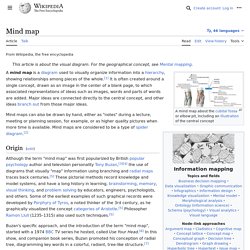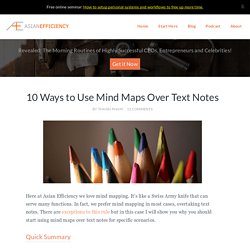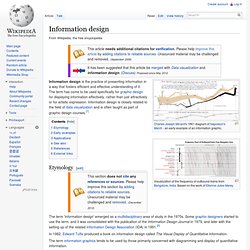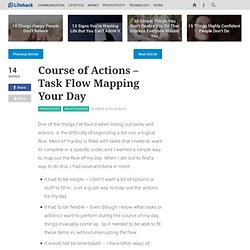

Mind map. A mind map about educational technology A mind map is a diagram used to visually organize information.

A mind map is hierarchical and shows relationships among pieces of the whole.[1] It is often created around a single concept, drawn as an image in the center of a blank page, to which associated representations of ideas such as images, words and parts of words are added. Major ideas are connected directly to the central concept, and other ideas branch out from those major ideas. Mind maps can also be drawn by hand, either as "rough notes" during a lecture, meeting or planning session, for example, or as higher quality pictures when more time is available. Mind maps are considered to be a type of spider diagram.[2] A similar concept in the 1970s was "idea sun bursting".[3] Origins[edit] The semantic network was developed in the late 1950s as a theory to understand human learning and developed further by Allan M.
Popularisation[edit] Guidelines[edit] Uses[edit] Research[edit] Features[edit] 10 Ways to Use Mind Maps Over Text Notes - Great Mindmapping Technique. Here at Asian Efficiency we love mind mapping.

It’s like a Swiss Army knife that can serve many functions. In fact, we prefer mind mapping in most cases, overtaking text notes. There are exceptions to this rule but in this case I will show you why you should start using mind maps over text notes for specific scenarios. Quick Summary. 7 Everyday Mind Mapping Uses with Examples. One simple way to extend your understanding and use of mind maps, is to simply use them in different situations and contexts.

Here are some simple everyday uses for mind maps (with examples). Quick Summary Think notes, think mind map. This is the best way to find potential mind map uses – think about where you normally take notes, and use a mind map instead.The common uses: summaries, brainstorming and ideation, problem solving, content creation, taking notes.The less-common uses: project management, planning, analyses and decision making, rapid thought recording.Download all the example mindmaps here. 5 Examples of Asian Efficiency Mind Maps (And See How We Mind Map) How to Build New Habits with Mind Maps and Mindmapping. Recently I had the opportunity to read a fantastic book on habits and how they really work backed with some scientific research.

What really stood out how the author was able to break down habits into different components that would make it much easier to adapt new habits and change old ones. With help of mind maps building new habits has become even easier. Here’s how. Quick Summary Each habit consists of a cue, routine and a reward.Mind maps support you in planning your habit and effectively overseeing it.Each mind map will have a branch for each habit component.Specify your plan of action and details in your mind map. Information aesthetics - Data Visualization & Information Design. Make a Mind Map to Keep on Top of Everything in Your Life. Create a Change Map So You Don't Forget to Adapt to New Circumstances.
Information design. Information design is the practice of presenting information in a way that fosters efficient and effective understanding of it.

The term has come to be used specifically for graphic design for displaying information effectively, rather than just attractively or for artistic expression. MindNode. Popplet. Supercharge yourself. Think, talk and work more creatively. Visual Thinking + Synthesis. Photo by Ken Yeung I really enjoy talking complex subjects, processes or business problems and boiling them down to their core essence.

This is becoming known as the process of "Visual Thinking". I use visual metaphors and storytelling to do this. My style of visual thinking is immediately recognizable and has helped me build a strong following of influential professionals who use my visuals in their own presentations and documents.
A comprehensive archive of my visuals can be found on Flickr (please credit if you use them) and if you are interested in Visual Thinking as a discipline, you can visit VizThink for additional resources. Five glorious presentations on visual thinking. Do you think in words or pictures, or both?

Visual thinking engages the part of the brain that handles visual processing, and is said to be both "emotional and creative" so you can "organise information in an intuitive and simultaneous way". A picture really might be worth a thousand words, while being easier to understand and recall. 100+ Self-Growth Mind Maps. Online Diagram Software and Flowchart Software - Gliffy. Visual learning and outlining in the classroom. Visual thinking is a learning style where the learner better understands and retains information when ideas, words and concepts are associated with images.

Research tells us that the majority of students in a regular classroom need to see information in order to learn it. Some common visual learning strategies include creating graphic organizers, diagramming, mind mapping, outlining and more. Visual learning helps students clarify their thoughts Students see how ideas are connected and realize how information can be grouped and organized.
With visual learning, new concepts are more thoroughly and easily understood when they are linked to prior knowledge. iSketch. Course of Actions - Task Flow Mapping Your Day. One of the things I’ve found when listing out tasks and actions, is the difficulty of organizing a list into a logical flow.

Most of my day is filled with tasks that I need or want to complete in a specific order, and I wanted a simple way to map out the flow of my day. When I set out to find a way to do this, I had several criteria in mind: It had to be simple – I didn’t want a lot of options or stuff to fill in. Just a quick way to map out the actions for my day.It had to be flexible – Even though I know what tasks or actions I want to perform during the course of my day, things invariably come up. So it needed to be able to fit these items in, without interrupting the flow.It would not be time-based – I have other ways of covering time-based stuff. A Task Flow Map is Born I played around with several methods, and many were way too complex. The worksheet I came up with has a set of boxes, one for each task, with a small arrow indicating the flow from one box, and task, to the next.
Mind mapping tool. The Art of Complex Problem Solving. Home. The Art of Complex Problem Solving. Tales from the Wonder Emporium: Visual and Creative Thinking in Business. Stormy-Mappers. Mind Mapping & Diagrams. Mind Mapping. Mind Maps/Thinking Maps/Graphic Organizers. Free Programs.